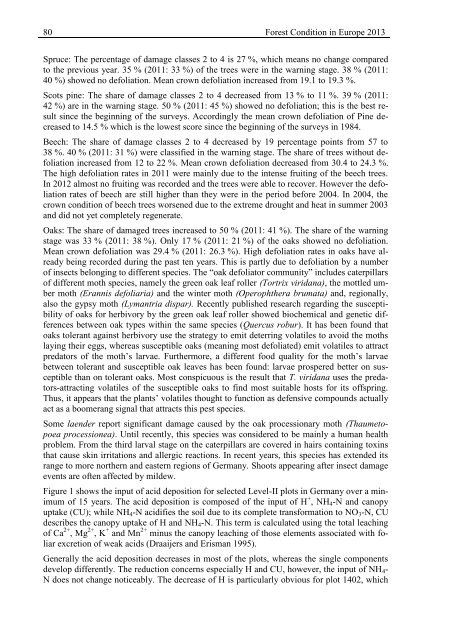Forest Condition in Europe - ICP Forests
Forest Condition in Europe - ICP Forests
Forest Condition in Europe - ICP Forests
Create successful ePaper yourself
Turn your PDF publications into a flip-book with our unique Google optimized e-Paper software.
80 <strong>Forest</strong> <strong>Condition</strong> <strong>in</strong> <strong>Europe</strong> 2013<br />
Spruce: The percentage of damage classes 2 to 4 is 27 %, which means no change compared<br />
to the previous year. 35 % (2011: 33 %) of the trees were <strong>in</strong> the warn<strong>in</strong>g stage. 38 % (2011:<br />
40 %) showed no defoliation. Mean crown defoliation <strong>in</strong>creased from 19.1 to 19.3 %.<br />
Scots p<strong>in</strong>e: The share of damage classes 2 to 4 decreased from 13 % to 11 %. 39 % (2011:<br />
42 %) are <strong>in</strong> the warn<strong>in</strong>g stage. 50 % (2011: 45 %) showed no defoliation; this is the best result<br />
s<strong>in</strong>ce the beg<strong>in</strong>n<strong>in</strong>g of the surveys. Accord<strong>in</strong>gly the mean crown defoliation of P<strong>in</strong>e decreased<br />
to 14.5 % which is the lowest score s<strong>in</strong>ce the beg<strong>in</strong>n<strong>in</strong>g of the surveys <strong>in</strong> 1984.<br />
Beech: The share of damage classes 2 to 4 decreased by 19 percentage po<strong>in</strong>ts from 57 to<br />
38 %. 40 % (2011: 31 %) were classified <strong>in</strong> the warn<strong>in</strong>g stage. The share of trees without defoliation<br />
<strong>in</strong>creased from 12 to 22 %. Mean crown defoliation decreased from 30.4 to 24.3 %.<br />
The high defoliation rates <strong>in</strong> 2011 were ma<strong>in</strong>ly due to the <strong>in</strong>tense fruit<strong>in</strong>g of the beech trees.<br />
In 2012 almost no fruit<strong>in</strong>g was recorded and the trees were able to recover. However the defoliation<br />
rates of beech are still higher than they were <strong>in</strong> the period before 2004. In 2004, the<br />
crown condition of beech trees worsened due to the extreme drought and heat <strong>in</strong> summer 2003<br />
and did not yet completely regenerate.<br />
Oaks: The share of damaged trees <strong>in</strong>creased to 50 % (2011: 41 %). The share of the warn<strong>in</strong>g<br />
stage was 33 % (2011: 38 %). Only 17 % (2011: 21 %) of the oaks showed no defoliation.<br />
Mean crown defoliation was 29.4 % (2011: 26.3 %). High defoliation rates <strong>in</strong> oaks have already<br />
be<strong>in</strong>g recorded dur<strong>in</strong>g the past ten years. This is partly due to defoliation by a number<br />
of <strong>in</strong>sects belong<strong>in</strong>g to different species. The “oak defoliator community” <strong>in</strong>cludes caterpillars<br />
of different moth species, namely the green oak leaf roller (Tortrix viridana), the mottled umber<br />
moth (Erannis defoliaria) and the w<strong>in</strong>ter moth (Operophthera brumata) and, regionally,<br />
also the gypsy moth (Lymantria dispar). Recently published research regard<strong>in</strong>g the susceptibility<br />
of oaks for herbivory by the green oak leaf roller showed biochemical and genetic differences<br />
between oak types with<strong>in</strong> the same species (Quercus robur). It has been found that<br />
oaks tolerant aga<strong>in</strong>st herbivory use the strategy to emit deterr<strong>in</strong>g volatiles to avoid the moths<br />
lay<strong>in</strong>g their eggs, whereas susceptible oaks (mean<strong>in</strong>g most defoliated) emit volatiles to attract<br />
predators of the moth’s larvae. Furthermore, a different food quality for the moth’s larvae<br />
between tolerant and susceptible oak leaves has been found: larvae prospered better on susceptible<br />
than on tolerant oaks. Most conspicuous is the result that T. viridana uses the predators-attract<strong>in</strong>g<br />
volatiles of the susceptible oaks to f<strong>in</strong>d most suitable hosts for its offspr<strong>in</strong>g.<br />
Thus, it appears that the plants’ volatiles thought to function as defensive compounds actually<br />
act as a boomerang signal that attracts this pest species.<br />
Some laender report significant damage caused by the oak processionary moth (Thaumetopoea<br />
processionea). Until recently, this species was considered to be ma<strong>in</strong>ly a human health<br />
problem. From the third larval stage on the caterpillars are covered <strong>in</strong> hairs conta<strong>in</strong><strong>in</strong>g tox<strong>in</strong>s<br />
that cause sk<strong>in</strong> irritations and allergic reactions. In recent years, this species has extended its<br />
range to more northern and eastern regions of Germany. Shoots appear<strong>in</strong>g after <strong>in</strong>sect damage<br />
events are often affected by mildew.<br />
Figure 1 shows the <strong>in</strong>put of acid deposition for selected Level-II plots <strong>in</strong> Germany over a m<strong>in</strong>imum<br />
of 15 years. The acid deposition is composed of the <strong>in</strong>put of H + , NH 4 -N and canopy<br />
uptake (CU); while NH 4 -N acidifies the soil due to its complete transformation to NO 3 -N, CU<br />
describes the canopy uptake of H and NH 4 -N. This term is calculated us<strong>in</strong>g the total leach<strong>in</strong>g<br />
of Ca 2+ , Mg 2+ , K + and Mn 2+ m<strong>in</strong>us the canopy leach<strong>in</strong>g of those elements associated with foliar<br />
excretion of weak acids (Draaijers and Erisman 1995).<br />
Generally the acid deposition decreases <strong>in</strong> most of the plots, whereas the s<strong>in</strong>gle components<br />
develop differently. The reduction concerns especially H and CU, however, the <strong>in</strong>put of NH 4 -<br />
N does not change noticeably. The decrease of H is particularly obvious for plot 1402, which
















